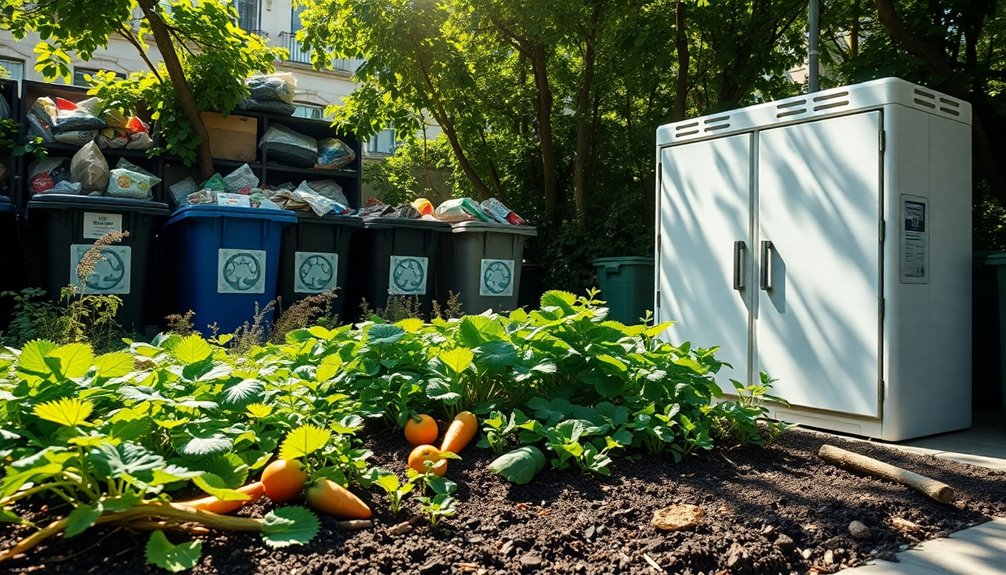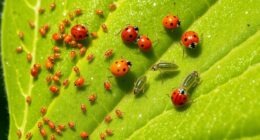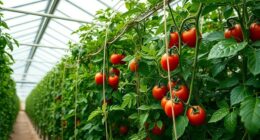Waste-to-nutrition paths can transform food scraps and agricultural waste into valuable nutrients, providing a sustainable solution to many environmental issues. By converting discarded biomass, you help reduce greenhouse gas emissions and promote a circular economy. These innovative processes not only address waste disposal but also enhance soil health and food security. As you explore this topic, you'll discover even more about how these methods contribute to a sustainable future and the benefits they offer.
Key Takeaways
- Waste-to-nutrition technologies convert food scraps and biomass into valuable nutrients, reducing reliance on arable land and promoting sustainability.
- Transforming waste into nutrients helps mitigate greenhouse gas emissions and addresses waste disposal challenges, contributing to environmental relief.
- Utilizing diverse feedstocks, including crop residues and animal by-products, enhances resource conservation and minimizes pollution in food systems.
- The waste-to-nutrition industry creates jobs and fosters local economies while promoting community engagement in sustainable practices.
- Nutrients generated through these processes can improve soil health, enhancing agricultural productivity and resilience against climate change.

As the world grapples with increasing waste and food insecurity, waste-to-nutrition paths offer a promising solution that transforms discarded biomass into valuable nutrients. These innovative processes convert waste materials like food scraps, crop residues, and animal by-products into nutritious products, aiming to reduce environmental impacts and support a circular economy. By utilizing these diverse feedstocks, waste-to-nutrition pathways can lessen the need for arable land, making food systems more sustainable.
You might be surprised to learn that food waste alone represents a significant portion of municipal waste, providing an incredible opportunity to generate valuable nutrients. Crop residues, such as straw and corn stalks, also hold substantial potential for conversion. Even materials from slaughterhouses can be repurposed, while sludge and wastewater can be transformed into nutritional products. Wood-related biomass like sawdust and wood chips further adds to the possibilities, demonstrating the versatility of these feedstocks.
The technological approaches behind waste-to-nutrition are equally impressive. Insect biorefineries, for instance, farm insects on waste biomass to create protein-rich feed. Microbial biorefineries utilize microorganisms to convert waste into bioactive compounds, while lignocellulosic biorefineries break down complex biomass to extract valuable nutrients.
Innovative technologies like insect and microbial biorefineries transform waste into valuable nutrients, highlighting the potential of waste-to-nutrition solutions.
These innovations not only address waste disposal issues but also help mitigate greenhouse gas emissions by avoiding methane release from landfills. By adopting these pathways, you contribute to resource conservation, reducing pollution related to waste disposal and agricultural runoff. The nutrients generated can enhance soil health, improving its structure and fertility.
Moreover, these practices provide a means to adapt to climate change, fostering resilience in food systems. The economic and social implications are significant. Waste-to-nutrition industries create jobs and respond to the growing demand for sustainable food products.
Frequently Asked Questions
How Can Individuals Participate in Waste-To-Nutrition Initiatives?
You can participate in waste-to-nutrition initiatives by embracing meal planning and using grocery lists to avoid overbuying.
Consider donating surplus food to local food banks or volunteering at recovery centers. Support community programs that redistribute excess food and educate others about safe food handling.
Get involved in workshops to improve your cooking skills and learn to repurpose leftovers.
What Types of Waste Are Most Suitable for Conversion?
Isn't it ironic that the stuff you throw away can actually become something useful?
You'd be surprised at the types of waste suitable for conversion! Fresh produce, stale bakery items, and surplus dairy can become animal feed.
Fruit and vegetable scraps can fuel biogas production. Even grains and oils can be transformed into biofuel.
Embracing these waste types not only reduces trash but also creates valuable resources.
Why not start today?
Are There Any Health Risks Associated With Waste-To-Nutrition Processes?
Yes, there are health risks associated with waste-to-nutrition processes. If waste isn't processed correctly, contaminants can remain, posing risks to your health.
Antinutritional factors can decrease the nutritional value of the end product, while harmful microbial decomposition can produce dangerous leachates.
To ensure safety, you must use advanced technologies and adhere to strict regulations. Proper training and handling are essential to minimize these risks and protect both consumers and workers.
How Do Waste-To-Nutrition Methods Impact Local Economies?
You'd think waste-to-nutrition methods could single-handedly save local economies, and they almost can!
By transforming food waste into valuable products, you create new jobs and revenue streams. Cities embracing these strategies enjoy economic boosts that can rival the most profitable industries.
Imagine harnessing wasted resources to spark innovation and sustainability! Plus, you're reducing environmental impacts, which makes your community healthier and more attractive to businesses.
It's a win-win that keeps on giving!
What Technologies Are Currently Used in Waste-To-Nutrition Systems?
In waste-to-nutrition systems, you'll find various innovative technologies at play.
Insect farming uses organic waste to produce protein-rich insects, while bioreactors cultivate microorganisms for sustainable proteins.
Additionally, biorefineries extract plant proteins from residues, enhancing food sustainability.
Technologies that convert food waste into animal feed are also gaining traction, ensuring nutritional value while managing waste.
Each of these methods emphasizes efficiency and scalability, making them vital for creating sustainable food systems.
Conclusion
In the grand tapestry of environmental recovery, waste-to-nutrition paths weave vibrant threads of possibility. By transforming discarded materials into nourishing resources, you're not just clearing clutter; you're planting seeds of hope. Each discarded item can sprout into something life-giving, painting a greener future where ecosystems thrive. So, as you embrace these innovative pathways, remember: every piece of waste holds the potential to bloom into a healthier, more sustainable world, one bite at a time.









